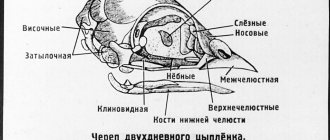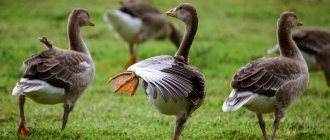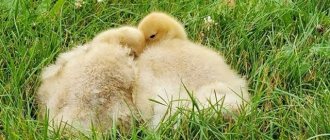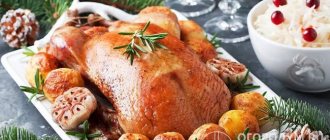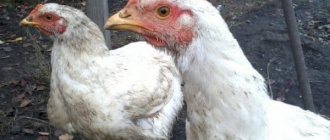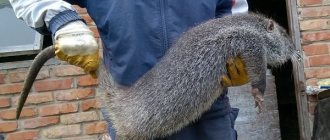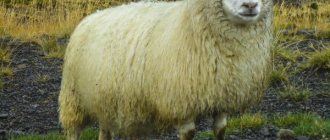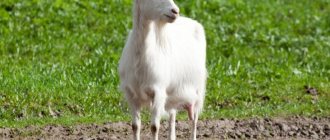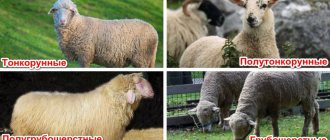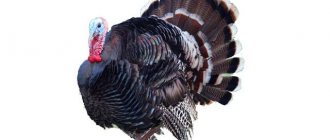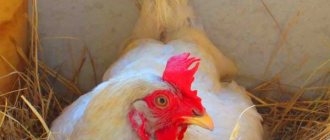Home » Articles about geese » How to slaughter a goose
The quality of the meat depends on the method of slaughtering poultry. Before slaughtering a goose, you should choose the most suitable method for yourself, acquire the necessary tools and prepare the bird in a special way.
Preparation for slaughter
Geese are slaughtered at the age of 5-6 months (in October-November). If there is not enough feed or there is no time to care for the livestock, then slaughter can begin in September (provided that the young animals have gained normal weight).
Geese begin to be actively fattened 3 weeks before slaughter, given nutritious wet mash in the morning and evening, and ready-made feed or barley in the afternoon (corn, peas, and wheat can also be used). Every day the geese should receive fresh, lush grass - the pasture is sown with cereals and legumes.
The mash is prepared in a volume that geese can eat at one time - such a mass cannot be stored. It is prepared from crushed grain mixture and liquid (whey, water, skim milk, broth) in a ratio of 1:1.5. The mixture is infused for 6 hours, adding feed yeast. While the grain absorbs moisture, boil the vegetables (potatoes, carrots). They are added to the mash along with chopped herbs and melons. It is also recommended to include meat and bone meal and wheat bran.
12 hours before slaughter, the geese are moved to a clean room. They stop feeding them and are given only water with the addition of Glauber's salt (laxative concentration - 2%). This is necessary to cleanse the intestines - if this is not done, the fat in the geese will acquire a greenish tint, and during gutting there is a high risk that the esophagus will rupture (the meat will be stained). Opinions differ regarding the duration of fasting (from 6 to 12 hours, and according to some sources - a day). The room should be dark - it is most convenient to move the bird overnight and start work in the morning.
Useful tips for beginners
There are rules that simplify work and improve results. A few tips will come in handy for beginners:
- Don't forget about your diet. In spring and summer they give more greens and plant foods, in the fall - mash and mixed feed.
- Since September, the geese have been allowed to walk less. This way fat accumulates better. Although movement and open air are important for health, the birds are still released. For a day walk, 1–1.5 hours is enough.
- The best producers are selected for breeding. Males with pronounced “leader” qualities are more suitable. Both the goose and the goose must be well-fed and healthy. Bright signs of the breed are welcome. This way the offspring turns out stronger, bigger and tastier.
- After slaughtering a goose, do not forget about the blood. Be sure to let it drain. The quality of the meat depends on this.
- Before slaughter, goose anatomy is studied. This seriously helps in slaughtering and dressing the bird properly.
- Use sharp instruments.
To get tasty meat, it is important not only to feed the goose well, but also to slaughter the bird in a timely manner. The quality and presentation of the carcass depends on how correctly the slaughter, gutting and cutting were carried out.
Slaughtering techniques
Before you kill a goose, it is worth familiarizing yourself with the theory. Several methods are used. To prevent the bird from resisting, its legs are tied and its wings are pulled back. For convenience, it is recommended to prepare a metal cone. Slaughter is carried out at some distance from the poultry house so that the rest of its inhabitants do not experience stress. A prerequisite is complete bleeding, otherwise the meat will not be stored.
Fresh blood can be used as a protein supplement in wet chicken mashes.
Chopping off the head
This method requires a deck and a sharp axe. The immobilized bird is placed on a block and the head is cut off with one sharp blow. The carcass is hung up. After complete bleeding, processing begins. Before slaughtering a goose, it is worth considering that the cut quickly turns black, which is why the carcass loses its presentation. In addition, with this method, the meat spoils faster (microbes get onto the cut of the neck from the block and penetrate deeper).
Unilateral external method
Before a bird is slaughtered, it is stunned with a blow to the head. After this, she is suspended by her feet or placed in a cone. Using a sharp small knife, make an incision 2 cm below the ear, cutting through the skin, carotid artery, and jugular vein. The head is held by the beak. The size of the incision is 2 cm.
Bilateral external method
The preparation is similar, but the incision is made not one-sided, but through. The head is held by the beak. The neck is pierced 2 cm from the ear. At a depth of about 15 mm, the knife is shifted to the right, cutting the arteries and veins, and brought out from the other side of the neck. The cut is neat and the blood drains quickly.
Internal method (split)
The preparatory stage remains the same. Cut the bird with a sharp knife or scissors with narrow blades. The head of the stunned goose is turned towards itself, the beak is opened, an instrument is inserted into it, and the blood vessels above the tongue are cut. Then the knife (scissors) is slightly moved toward you and an injection is made lower and to the right, reaching the anterior part of the cerebellum. The carcass is bled. Due to the piercing of the cerebellum, the bird's body relaxes and handling becomes easier.
How to pluck a wild goose
You can pluck wild geese in the same way as farmed geese, since they are almost no different from them. You can use any of the options listed.
How to singe a carcass after plucking
As fire sources you can use: a blowtorch, bunches of dry straw, paper, a gas burner.
You can singe a goose like this:
- Make sure that all feathers and even fine fluff are removed from the skin.
- Wipe the goose with a dry cloth so that it does not remain damp and no soot remains on it.
- Rub the skin with regular flour or fine bran to reduce the likelihood of an unpleasant burning smell.
- Bring the fire to the skin, and stretching it, treat the entire surface, including hard-to-reach places under the wings and on the legs.
- You must act carefully so as not to burn the goose bumps.
Every poultry farmer can learn how to quickly and correctly singe carcasses if he regularly practices this necessary task.
How to get feathers without killing birds
At home, you can pluck not only dead but also live geese. Product collection begins immediately after the end of egg laying, usually in the summer, in June or July, when they begin to molt. In the southern regions, this can be done again in the fall, during the autumn molting period. Plucking feathers during this period is much easier.
Before the start of the procedure, the day before, the geese are given the opportunity to bathe - they are driven out to a pond or bowls of water are placed. After plucking, they are left in the pen for a day and then returned to the others.
The process of plucking live geese is as follows:
- The bird's wings and both legs are tied, and then placed on one's lap.
- First, pluck the breast, sorting through and removing only the old feathers. They are different from new, clean, bright and dense. Young new feathers are not plucked.
- The feathers are not pulled out completely, but partially.
- Then they turn the goose onto its stomach and pluck the back. The rest of the body is not touched.
If blood appears on the skin during surgery, the bird must be released.
How to properly cut a goose carcass
After slaughtering, they begin cutting up the goose carcass. The ability to butcher a goose is a necessary skill for any housewife, as is plucking it.
Step by step steps:
- Place on a cutting board.
- Cut off the goose's head at the 2nd cervical vertebra, then the wings to the bends of the elbows and the flippers to the joints.
- Pull out the trachea along with the esophagus.
- Using a sharp knife, cut the abdomen, starting from the cloaca to the keel bone. The main thing is not to cut the intestines.
- Remove all giblets, but leave the liver. Be careful with your gall bladder; if it accidentally bursts, the meat will be unfit for consumption.
When the goose is gutted, rinse the carcass in cold running water and set aside to cool for 2-3 hours.
Plucking geese
Several plucking methods are used - steaming the carcass is considered the least labor-intensive.
Dry method
Feathers are pulled out before the carcass has cooled, without subjecting it to any preliminary preparation. Plucking begins with large flight feathers located on the wings and tail, then moves to the chest, neck, and legs. Feathers are pulled out in the direction of their growth.
Wet method
The carcass is immersed in hot water (+75…+80°C). You can keep the goose in it for no longer than 5 minutes, otherwise the skin will tear. After this, they begin plucking according to the usual pattern. Disadvantages of the method:
- it will not be possible to sort down and feathers;
- meat is not suitable for long-term storage - it must be used immediately.
Steaming
With this method, the carcass is filled with air using a pump - a tube is placed in the neck. When the wings open, the air supply process is stopped, the neck is tightly bandaged with a tourniquet so that the air does not escape. The bird is covered with damp burlap and a separate section is steamed using a steam generator (exposure duration is 8 seconds). After removing the feathers, move on to the next area, repeating the steaming.
Reviews from the network
Alexandra Sipko, 54 years old
I slaughter geese like this:
1. I select a goose before the next feeding, set it aside separately, then feed all the geese.
2. You need an assistant - it’s not easy to handle a goose alone. In my case, it’s my husband. I lay the goose on its belly on the ground, hold it by the paws with one hand and the wings with the other. We place the goose's head on a stump, holding it by the beak with one hand, and chop the neck with a cleaver with the other.
3. The goose needs to be lifted immediately, holding it by the paws and without letting go of the wings, let the blood drain for about 5 minutes.
4. I put the goose in a large saucepan (two buckets), and pour boiling water over it, but not immediately remove the bubbling water, but let it sit without heat for about five minutes, but no more, and close the lid for a few minutes so that it steams and makes it easier to pinch. But under no circumstances should you overexpose it, otherwise the skin will tear.
5. I take the goose out, let the water drain a little, and pluck it.
6. The goose needs to be oiled to remove any remaining downy hairs. It is better to do this with a gas burner or a blowtorch, but you can also successfully use a gas stove if the goose is not too heavy.
7. Wash the carcass under running water using a metal scraper that is not too hard.
8. Gutting: carefully, so as not to touch the intestines, I cut the skin of the belly from bottom to top, then cut the neck to the pit on the breast. I remove the fat from the stomach, cut the film on all sides, and using a thin long knife, lifting the giblets from below (do not crush the liver!!! well, if they are crushed, rinse immediately with plenty of water), carefully separate the esophagus tube, as much as I can get, and do the same from above the neck, freeing the esophagus and trachea.
Then with one hand I pull the giblets back, and with the other I trim the film from below, and cut out the cloaca along with the tail (it contains the sebaceous glands). Next, I separate the fat from the intestines, free the liver from the gallbladder (I cut it out along with a piece of the liver), cut the stomach, remove the internal hymen. The whole process takes 2 - 2.5 times.
Victor Zabolov 2015.03.14 21:19
I forgot to add, why hang the goose immediately after cutting off its head? It is not right. He twitches violently for some time, and this causes blood to splatter in all directions. And the goose’s wings are quite strong, and he hits them very hard. When I chopped it for the first time I didn’t know, it was terrible what happened. Then a neighbor told me that I needed a special device, like a cone with a cut off top, which was firmly attached to a wall, fence, or tree at the height of a person’s chest. Then they stick the condemned goose in there upside down. His head pokes out of the hole from below, and his body gets stuck inside the cone. So we chop off the head, and then wait for the bird to drain. Simple and very effective. I use this method myself and recommend it to everyone.
Carcass cutting
Poultry is cut using a sharp knife treated with boiling water or disinfected culinary scissors. First, the abdomen is opened along the keel and the entrails are removed (when making a cut, it is important not to damage the intestines). Inedible parts are discarded, the liver is set aside, the gizzard is cut and cleared of contents.
The head is cut off at the second cervical vertebra. The legs are cut at the level of the metatarsus, the wings - at the elbow joint. The carcass is washed to clean water. Fat is removed if necessary.
At what age is it better to kill?
The meat of young animals at the age of 6–7 months has the most valuable taste qualities, which is why the poultry is slaughtered closer to the New Year (October–November).
In winter, geese noticeably lose weight, which is why it is not advisable to choose this time. Slaughter is allowed at 3–4 months if the individuals received adequate food and gained at least 4 kg by this age.
Storage
Gutted goose can be stored in the refrigerator at 0°C for up to 10-14 days (at +2...+3°C the period is reduced to 3 days). It is recommended to wrap the carcass in parchment, foil, or a cloth soaked in a vinegar solution. Long-term storage (up to 1 year) is possible in the freezer. Before placing a whole carcass there, it needs to be kept in the refrigerator for a day.
Even knowing how to kill a goose correctly, you can make serious mistakes in practice and cause unnecessary suffering to the bird. When slaughtering for the first time, it is better to invite an experienced person to help you, who will show you all the intricacies of the process.
- Related Posts
- Incubation time for goose eggs
- Feeding geese from the first day of life
- The goose fell to his feet
- Profitability of breeding geese
- Breeds of domestic geese
- Geese breed Linda
When is the best time to slaughter a goose: external signs and age
Geese are considered long-lived and can live for decades, but when bred at home for meat, their lifespan is much shorter - only a few months.
The timing when a fattened bird can be slaughtered depends on its breed, nutrition, and conditions of detention, but, in general, geese can be slaughtered at the age of 2.5 months. At this time, they can weigh 4 kg, which is quite enough to obtain a finished meat carcass.
When slaughtered after 70-75 days, the quality of the carcass deteriorates (it will be covered with “stumps”), since during this period they begin to form new feathers. Therefore, if the goslings have already begun to grow new feathers, it is better to postpone slaughter until 4 months of age.
You can determine that a goose is suitable for slaughter by the following criteria:
- there should be no “stumps” on its body; this can be determined by running your hand along the feathers against the height;
- the bird must be well-fed and have good weight, at least 4 kg. At this time, goose meat is not yet fatty and has dietary qualities.
How to prepare a bird for slaughter
In the matter of raising geese for meat, their preparation for slaughter is not the least important. This is important, since an improperly prepared carcass will be inconvenient to pluck and cut. First of all, birds that are being prepared for slaughter are stopped feeding to empty their intestines of contents.
Geese are not fed for about 18-24 hours before slaughter, but they are given clean, lightly salted water. Pre-slaughter fasting promotes better preservation of the carcass. While the birds are starving, they must be placed separately from the main flock.
How to gut?
Gutting a carcass is a mandatory process, since not all internal organs can be eaten, and some simply need to be removed so as not to spoil the meat.
Incomplete
Incomplete evisceration involves cleaning the carcass from the digestive organs. Through a longitudinal incision on the front of the body, the cloaca and intestines are removed. The stomach is cut off from the intestines and cleansed of waste products. At the end of the process, the cuticle (inner stratum corneum) is separated.
Complete
With this method, the legs and head are cut off and all internal organs are removed. They start with the heart, then remove the trachea and esophagus, and after that, by cutting the chest and abdominal cavity, the remaining offal (lungs, spleen, intestines, stomach, liver, etc.) and genitals are removed.
